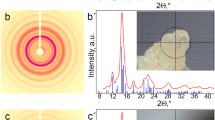Summary
The fine structure of the human arachnoid villi was studied to clarify the origin of psammoma bodies. Within the villous surface layer, collagen fibrils and fine granular material clustered forming microcores of variable caliber measuring up to 10 μm. An early stage of psammoma body formation was seen more frequently in these villous microcores than in the meningocytic whorls. The villous microcores contained a large number of membrane-free matrix granules as well as a small number of membranebound matrix vesicles and matrix minerals. The matrix granules were irregularly oval structures with electronlucent halo, measuring 0.05–0.70 μm in diameter. Hydroxyapatite crystals were frequently precipitated within and around the matrix granules which aggregated with calcifying matrix vesicles and matrix minerals. Numerous calcifying matrix granules were present within and around enlarging psammoma bodies. The matrix granules may serve as the principal calcification nidi of psammoma bodies in the human arachnoid villi. The possible mechanisms of matrix granule biogenesis are extrusion of preformed arachnoid cell structures or secretion of fine granular material with its extracellular assemblage.
Similar content being viewed by others
References
Ali SY (1976) Analysis of matrix vesicles and their role in the calcification of epiphyseal cartilage. Fed Proc 35:135–142
Anderson HC (1969) Vesicles associated with calcification in the matrix of epiphyseal cartilage. J Cell Biol 41:59–72
Anderson HC (1976) Matrix vesicle calcification Fed Proc 35:105–108
Bonucci E (1967) Fine structure of early cartilage calcification. J Ultrastruct Res 20:33–50
Johannessen JV, Sobrinho-Simões M (1980) The origin and significance of thyroid psammoma bodies. Lab Invest 43:287–296
Kim KM (1976) Calcification of matrix vesicles in human aortic valve and aortic media. Fed Proc 35:156–162
Kubota T, Hirano A, Yamamoto S, Kajikawa K (1984) The fine structure of psammoma bodies in meningocytic whorls. J Neuropathol Exp Neurol 43:37–44
Kubota T, Sato K, Yamamoto S, Hirano A (1984) Ultrastructural study of the formation of psammoma bodies in fibroblastic meningioma. J Neurosurg 60:512–517
Kubota T, Hirano A, Sato K, Yamamoto S (1984) Fine structure of psammoma bodies in meningocytic whorls. Arch Pathol Lab Med 108:752–754
Kubota T, Hirano A, Sato K, Yamamoto S (1985) Fine structure of psammoma bodies at the outer aspect of blood vessels in meningioma. Acta Neuropathol (Berl) 66:163–166
Lipper S, Dalzell JC, Watkins PJ (1979) Ultrastructure of psammoma bodies of meningioma in tissue culture. Arch Pathol Lab Med 103:670–675
Rabinovitch AL, Anderson HC (1976) Biogenesis of matrix vesicles in cartilage growth plates. Fed Proc 35:112–116
Author information
Authors and Affiliations
Rights and permissions
About this article
Cite this article
Yamashima, T., Kida, S., Kubota, T. et al. The origin of psammoma bodies in the human arachnoid villi. Acta Neuropathol 71, 19–25 (1986). https://doi.org/10.1007/BF00687957
Received:
Accepted:
Issue Date:
DOI: https://doi.org/10.1007/BF00687957




